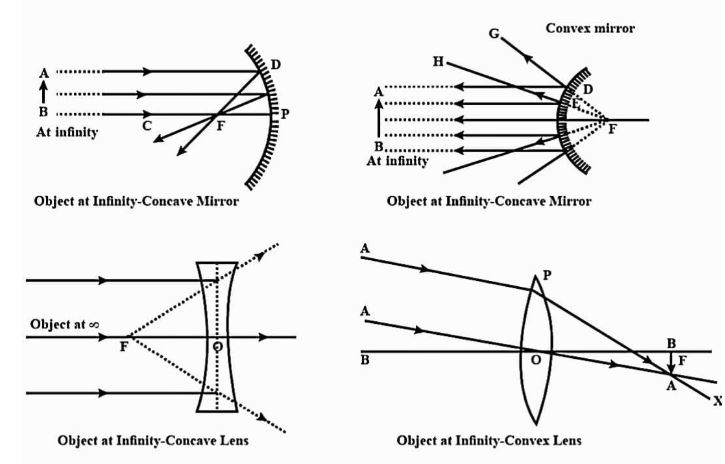
In which of the following, the image of an object placed at infinity will be highly diminished and point sized?
A. Concave mirror only
B. Convex mirror only
C. Convex lens only
D. Concave mirror, convex mirror, concave lens and convex lens.
Answer
367.5k+ views
Hint:Ray diagrams assist us in tracing the path of light for a person viewing a point on an image of an item. The incident and reflected rays are represented by lines with arrows in a ray diagram. It also aids us in determining the direction of the light.
Complete step by step answer:
When light rays from infinity strike a concave mirror, convex mirror, concave lens, or convex lens, a drastically decreased picture is generated at the focus, as illustrated in the figure.
The mirror equation and lens equation can be used to confirm this.
Mirror Equation is given by: $\dfrac{1}{v} + \dfrac{1}{u} = \dfrac{1}{f}$
Lens Equation is given by: $\dfrac{1}{v} - \dfrac{1}{u} = \dfrac{1}{f}$
Substituting \[u = - \,\infty \] , \[v = f\]
Magnification \[m = \dfrac{v}{u} = \dfrac{f}{\infty } = 0\]
Hence, the image is point size.

So, the correct option is D.
Note: The focal length of all optical lenses is the distance from the lens to the focus point along the optical axis of the lens. The focal length of a lens is determined by three factors: the radius of curvature of the lens, the refractive index of the substrate from which the lens is constructed, and the medium in which the lens sits. Lenses with a highly curved shape and a high refractive index that are placed in a medium with a big difference in refractive index will have a shorter focal length and thus be more powerful. A lens' focal length can be estimated using the lens manufacturer's formula.
Complete step by step answer:
When light rays from infinity strike a concave mirror, convex mirror, concave lens, or convex lens, a drastically decreased picture is generated at the focus, as illustrated in the figure.
The mirror equation and lens equation can be used to confirm this.
Mirror Equation is given by: $\dfrac{1}{v} + \dfrac{1}{u} = \dfrac{1}{f}$
Lens Equation is given by: $\dfrac{1}{v} - \dfrac{1}{u} = \dfrac{1}{f}$
Substituting \[u = - \,\infty \] , \[v = f\]
Magnification \[m = \dfrac{v}{u} = \dfrac{f}{\infty } = 0\]
Hence, the image is point size.

So, the correct option is D.
Note: The focal length of all optical lenses is the distance from the lens to the focus point along the optical axis of the lens. The focal length of a lens is determined by three factors: the radius of curvature of the lens, the refractive index of the substrate from which the lens is constructed, and the medium in which the lens sits. Lenses with a highly curved shape and a high refractive index that are placed in a medium with a big difference in refractive index will have a shorter focal length and thus be more powerful. A lens' focal length can be estimated using the lens manufacturer's formula.
Recently Updated Pages
What percentage of the area in India is covered by class 10 social science CBSE

The area of a 6m wide road outside a garden in all class 10 maths CBSE

What is the electric flux through a cube of side 1 class 10 physics CBSE

If one root of x2 x k 0 maybe the square of the other class 10 maths CBSE

The radius and height of a cylinder are in the ratio class 10 maths CBSE

An almirah is sold for 5400 Rs after allowing a discount class 10 maths CBSE

Trending doubts
The Equation xxx + 2 is Satisfied when x is Equal to Class 10 Maths

Why is there a time difference of about 5 hours between class 10 social science CBSE

Who was Subhash Chandra Bose Why was he called Net class 10 english CBSE

Change the following sentences into negative and interrogative class 10 english CBSE

Write a letter to the principal requesting him to grant class 10 english CBSE

Explain the Treaty of Vienna of 1815 class 10 social science CBSE




